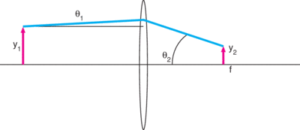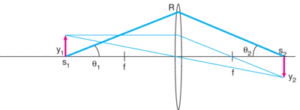Fiber Optic Coupling
The problem of coupling light into an optical fiber is really two separate problems. In one case, we have the problem of coupling into multimode fibers, where the ray optics of the previous section can be used. In the other case, coupling into single-mode fibers, we have a fundamentally different problem. In this case, one must consider the problem of matching the mode of the incident laser light into the mode of the fiber. This cannot be done using the ray optics approac
h, but must be done using the concepts of Gaussian Beam Optics.
Application 5: Coupling Laser Light into a Multimode Fiber
When we look at coupling light from a well-collimated laser beam into a multimode optical fiber, we return to the situation that was illustrated in Figure 5. The radius of the fiber core will be our y2. We will have to make sure that the lens focuses to a spot size less than this parameter. An even more important restriction is that the angle from the lens to the fiber θ2 must be less than the NA of the optical fiber. Let’s consider coupling the light from a R-30990 HeNe laser into an F-MSD fiber. The laser has a beam diameter of 0.81 mm and divergence 1.0 mrad. The fiber has a core diameter of 50 μm and an NA of 0.20. Let’s look at the coupling from the beam into the fiber when a M-20X objective lens is used in an F-915 or F-915T fiber coupler.
Let’s consider coupling the light from a R-30990 HeNe laser into an F-MSD fiber. The laser has a beam diameter of 0.81 mm and divergence 1.0 mrad. The fiber has a core diameter of 50 μm and an NA of 0.20. Let’s look at the coupling from the beam into the fiber when a M-20X objective lens is used in an F-915 or F-915T fiber coupler.
The objective lens has an effective focal length of 9 mm. In this case, the focused beam will have a diameter of 9 μm and a maximal ray of angle 0.05, so both the spot diameter and angle are well within the parameters of the fiber.
Generally, coupling light from a well-collimated laser source into a multimode fiber is not a difficult problem. If the user assures that the maximal ray of the focused beam is well within the NA of the fiber, then effective coupling will be accomplished.
Figure 5
Application 6: Coupling Light from a Diffuse Source into a Multimode Fiber
The previous application involved focusing a collimated source onto the end face of a fiber. This new application involves imaging the light from an extended diffuse source onto the fiber’s end face. This is similar to Application 4 where we focused the light from an extended source to a small spot. In the present application, we use a fiber to collect light from a source. By diffuse, we mean that the source emits light in all directions and that the intensity of light is independent of direction. An example of this is an incandescent lamp or a fluorescing sample.
Figure 9
Figure 9 shows the situation where we do 1:1 imaging from the source into the fiber. From the Gaussian lens equation, we have s1 = s2 = 2f in this configuration. Since y2 is simply the radius of the receiving fiber, the light is collected only from an area of the source of radius y1 = y2. The maximum angle coupled into the fiber is restricted by θ2 = NA. Since this is a 1:1 imaging problem, the maximum angle sampled from the light source is then also θ1 = NA. Thus, it is the fiber and not the lens that puts the restriction on how much light is collected. As long as we choose a lens with sufficiently small f/#, that is f/# <1/(2NA), then we will collect the maximum possible amount of light from the source into the fiber. Note what happens if we remove the lens and move the fiber directly against the source. That is, we butt couple the fiber to the source. In that case, the fiber collects light from an area of radius y2 and angle NA. But, this is exactly what we accomplished in our 1:1 imaging. An imaging system collecting light from a diffuse source into a fiber cannot collect more than could be collected by butt coupling.
Note what happens if we remove the lens and move the fiber directly against the source. That is, we butt couple the fiber to the source. In that case, the fiber collects light from an area of radius y2 and angle NA. But, this is exactly what we accomplished in our 1:1 imaging. An imaging system collecting light from a diffuse source into a fiber cannot collect more than could be collected by butt coupling.
In fact, this is a completely general result. Consider a configuration more like Figure 7, where we might choose, for example, to condense light onto the fiber end face from an area of the source with y1 = 5y2. We are now collecting light from an area that is 25x larger than the area of the fiber. However, the optical invariant tells us that we must now have θ1 = NA/5, so we are collecting light from a solid angle that is reduced by the same factor of 25. Thus, the total light that is collected, irradiance x area x solid angle, is constant. What a lens system can achieve is only to retrieve the efficiency of butt coupling when the fiber must be placed at a distance from a diffuse source. Therefore, for maximum efficiency, choose a fiber with the largest possible core diameter and the largest available numerical aperture.
Application 7: Coupling Laser Light into a Single-Mode Fiber
When we need to couple laser light into a single-mode fiber, we move from the ray optics picture in which we have worked to this point to a Gaussian mode-matching problem. This application is included here for completeness in discussing coupling light into optical fibers.
In order to couple light of wavelength λ from a collimated laser beam of 1/e2 diameter D into a fiber of mode field diameter ω, choose a lens with a focal length f = D( πω/4λ)
Let’s consider the situation where we use a Newport F-915 fiber coupler to couple light from a R-30992 laser (λ = 633 nm, D = 1.2 mm) into a Newport F-SV optical fiber (ω = 4.3 μm). We find f = 6.4 mm. For this application, use the Newport M-20X objective, f = 9 mm, as the closest fit to the correct focal length.
The coupling efficiency depends upon the overlap integral of the Gaussian mode of the input laser beam and the nearly Gaussian fundamental mode of the fiber. This overlap integral is the same whether the input mode is the larger or the smaller of the two modes. The focal length of the M-20X is too large by a factor of 1.4 while the focal length of the M-40X too short by a factor of 0.7, so the M-20X will be the better fit for this application.


